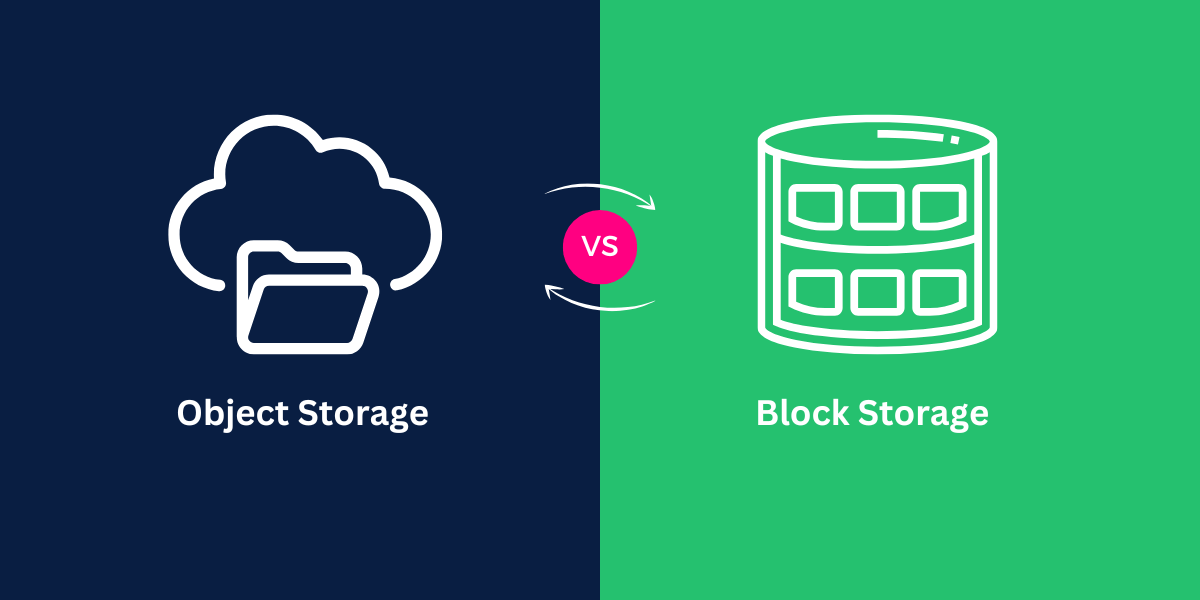What are the Difference Between Object Storage and Block Storage?
Object storage and block storage are two main types of data storage systems that serve different purposes. Block storage splits data into fixed-size blocks with unique identifiers, making it ideal for databases and operating systems that need fast, direct data access. Object storage saves data as objects with metadata and unique identifiers, which works well for storing large amounts of unstructured data like images, videos, and documents. Each system offers specific benefits for different storage needs.
A Head to Head Comparison Between Object Storage vs Block Storage
| Feature | Object Storage | Block Storage |
|---|---|---|
| Data Structure | Stores data as objects (files) with metadata | Stores data in fixed-size blocks |
| Access Method | Accessed via APIs (HTTP/REST) | Accessed via storage protocols (iSCSI, Fibre Channel) |
| Scalability | Highly scalable, ideal for large data sets | Limited scalability compared to object storage |
| Performance | Generally slower for small, frequent access | High performance for transactional I/O |
| Use Cases | Best for unstructured data (e.g., multimedia, backups) | Best for structured data (e.g., databases, VM storage) |
| Metadata | Rich metadata support for each object | Limited metadata capabilities |
| Durability | High durability with data replication and distribution | Durability depends on the underlying hardware and configuration |
| Cost | Often lower cost for large volumes of data | Typically higher cost per GB |
| Data Management | Easier to manage large datasets with built-in versioning | Requires more complex management (e.g., LVM) |
| Concurrency | Supports massive concurrency for access | Limited concurrency due to locking mechanisms |
What is Object Storage?
Object Storage is a data management system that handles data as distinct objects in a flat structure. Each object contains the data, metadata, and a unique identifier. This storage method stores files without folders or complex hierarchies, making it effective for large amounts of unstructured data. Object storage excels at storing photos, videos, backups, and static website content. Companies use object storage for cloud applications, content delivery, and data archiving tasks. Organizations maximize their storage efficiency by implementing data strategy services to optimize their object storage architecture and data management processes.
What is Block Storage?
Block Storage is a data storage method that breaks data into equal-sized blocks and stores each block independently. Each block gets a unique address, letting systems find and manage data quickly. The storage system handles data like a hard drive, making it perfect for operating systems, databases, and applications that need fast data access. Block storage works well for tasks that need frequent data updates and consistent performance, such as running virtual machines or hosting business applications.
What are the Key Differences between Object Storage and Block Storage
Object storage and block storage architectures have several key differences:
Data Structure
As the names imply, the core difference is in how data is stored:
- Object storage saves data as objects in a flat structure. There is no hierarchy or folders.
- Block storage divides data into blocks of fixed size, such as 512 bytes or 4 KB. The blocks are then organized into a hierarchical structure—blocks make up file systems, which can contain folders, files, and so on.
This impacts the metadata associated with the data. Object storage includes metadata with each object, such as name, creation date, owner, etc. File systems on block storage have their own metadata to represent hierarchy, access permissions, etc.
Scalability
Object and block offer different scalability models:
- Object storage scales horizontally—additional capacity is added just by deploying new object storage servers. Each server adds storage and requests capacity independently.
- Block storage scales vertically—capacity and performance are coupled within a single system. Adding capacity requires deploying additional disks into the same storage system.
Horizontal scaling is more flexible and cost-efficient than vertical scaling. Object storage can grow linearly, while block storage has fixed increments based on disk sizes.
Performance
- Object storage is optimized for large reads and writes. Performance scales with the number of objects, and small updates are slower.
- Block storage handles small random reads/writes very efficiently. Performance is consistent irrespective of capacity. However, reads/writes of large objects are limited.
Block storage delivers lower latency and higher IOPS for transactional workloads. Object storage provides high throughput for large reads/writes common in media serving, backups etc.
APIs and Protocols
Object and block storage use different protocols to read/write data:
- Object storage exposes simple REST APIs over HTTP. Operations like GET, PUT, and DELETE can be used to access objects.
- Block storage uses protocols like iSCSI, FC, etc., to read/write blocks. Operating systems manage files and filesystems.
Object storage integrates seamlessly with web-based access, while block storage requires low-level protocols. However, object protocols have a higher overhead compared to block protocols.
Durability/Availability
Object storage and block storage use different techniques to provide resiliency:
- Object storage replicates objects across multiple servers/facilities. If one node fails, an identical copy on another node is used. Erasure coding can store data even more durably.
- Block storage relies on redundant power, controllers, networking, and disks within a single storage array. Advanced systems offer dual controllers to remove single points of failure.
Object storage has higher fault tolerance built into the architecture, while block storage provides high availability within a single system.
Consistency
Consistency refers to reading the latest copy of data. Object and block storage have tradeoffs here:
- Object storage follows eventual consistency. Updates take time to propagate, so reads may get stale data temporarily.
- Block storage provides strong consistency. All reads return the latest data but writes suffer latency while waiting for data to be committed to disk.
Applications that need real-time data consistency favor block storage, while object storage provides higher availability and partition tolerance.
Geographic Distribution
- Object storage readily allows deploying storage across multiple data centers and regions. Objects are replicated intelligently based on usage patterns.
- Block storage is generally limited to a single region or data center. Synchronous replication can extend it across longer distances with higher costs and complexity.
Object storage simplifies building distributed cloud-native applications that need to store and access data globally. Block storage suits localized applications within a single facility.
Encryption
Both object and block storage provide encryption capabilities today
- Object storage supports encrypting data at rest transparently. All objects are encrypted, with keys managed securely.
- Block storage can encrypt data volumes and disks. Encryption has to be configured volume by volume.
Object storage makes encryption ubiquitous, while block storage requires planning to encrypt storage volumes.
Cost
Both object and block storage have different cost structures:
- Object storage follows pay-per-use pricing based on capacity consumed. More data stored and transferred raises costs.
- Block storage has fixed pricing based on allocated capacity and IOPS. Utilization does not affect cost.
Object storage simplifies building distributed cloud-native applications that need to store and access data globally. Block storage suits localized applications within a single facility.
Object Storage Use Cases
- Cloud storage
- Backup and archival
- Media content repositories
- Data lakes
- Static web hosting
Block Storage Use Cases
- Databases
- Transactional systems
- Application runtime storage
- Big data analytics
Comparing Major Cloud Providers
The top cloud platforms all offer both object storage and block storage services:
Amazon Web Services (AWS)
- Object Storage: Simple Storage Service (S3)
- Block Storage: Elastic Block Store (EBS)
Microsoft Azure
- Object Storage: Blob Storage
- Block Storage: Managed Disks
Google Cloud Platform (GCP)
- Object Storage: Cloud Storage
- Block Storage: Persistent Disk
While the services share similar core capabilities, they differ in features like access tiers, availability zones, replication options, transfer acceleration, etc. Performance and pricing also vary across providers.
Businesses should evaluate multiple options to choose cloud storage optimally based on workload needs and total cost. Provider lock-in should also be considered.
When to choose Object Storage vs Block Storage
Some general guidelines on when to select object vs block storage:
Pick Object Storage For:
- Storing large volumes of unstructured data
- Serving media files or static web content
- Building data lakes
- Backing up data off-site
- Applications that need geographically distributed data
Pick Block Storage For:
- Structured databases
- Transactional systems
- Boot/runtime storage for VMs
- High-performance analytics
- Low latency access to data
- Local applications in a single facility
However, the lines between the two approaches are blurring as they adopt capabilities from each other. For instance, object storage now provides features like object locking, multipart uploads, directory emulation, etc., while block storage has incorporated scale-out, protocol access, replication across regions, etc.
Often a hybrid architecture using both block and object storage together provides the optimal balance.
Final Thoughts
In summary, object storage and block storage provide two fundamental data storage architectures optimized for different use cases. Object storage handles massive volumes of unstructured data accessed globally using REST APIs. It offers metadata-rich capabilities that scale out linearly.
Block storage delivers low latency performance for transactional workloads via block protocols. It scales up within a single system and provides strong data consistency.
Understanding the core differences helps engineers architect storage tiers that best match application needs. Very often a hybrid approach delivers the flexibility to get the best of both object and block storage worlds.
Frequently Asked Questions (FAQs)
What is object storage?
Object storage saves data as objects with metadata and unique identifiers. It stores files, images, and videos in a flat structure without folders, making it ideal for large-scale data storage.
What is block storage?
Block storage divides data into fixed-size blocks with unique addresses. It provides fast read/write speeds and works well for operating systems, databases, and applications that need quick data access.
Which storage type offers better scalability?
Object storage offers superior scalability. Users can add storage capacity without limits, while block storage has physical hardware limitations and requires more complex scaling procedures.
How do costs compare between object and block storage?
Object storage costs less because it uses standard hardware and scales easily. Block storage costs more due to specialized hardware requirements and complex management needs.
Which storage type is better for databases?
Block storage works better for databases because it provides faster data access and consistent performance. Object storage is too slow for database operations that need immediate data updates.
What are the main security differences?
Block storage offers security at the volume level with encryption. Object storage provides security for individual objects and includes access controls for each stored item.

Priya Mervana
 Verified Web Security Experts
Verified Web Security Experts
Priya Mervana is working at SSLInsights.com as a web security expert with over 10 years of experience writing about encryption, SSL certificates, and online privacy. She aims to make complex security topics easily understandable for everyday internet users.



